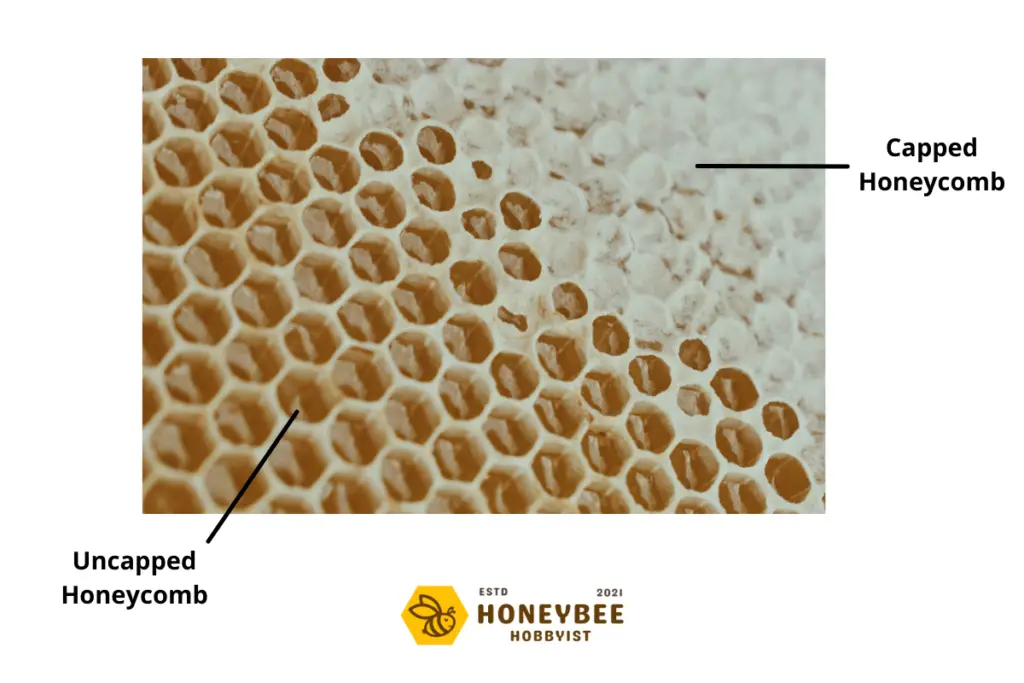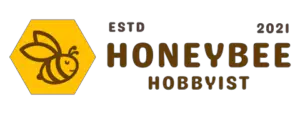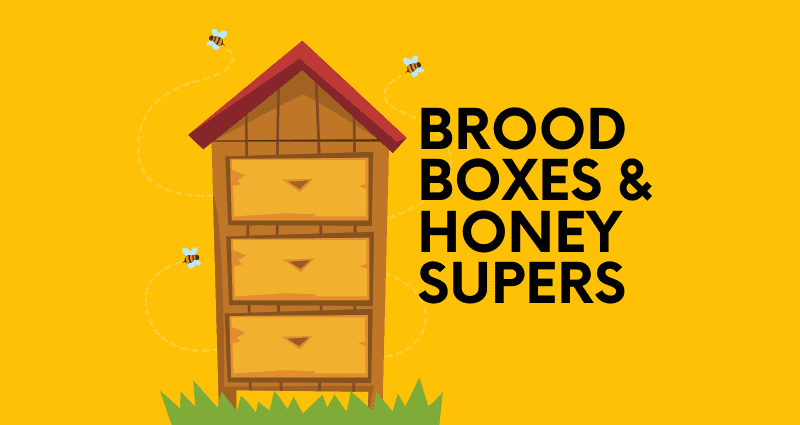Brood Box vs. Honey Super
A brood box, or brood chamber, is the space in a beehive that the queen bee lays its eggs. The honey super is the space worker bees use to produce and store honey. Each contain frames with hexagonal honeycomb in which the bees place raw honey or lay eggs.
Primarily made of wood, these two spaces that make up the hive body are important aspects of honeybee production and hive health.
What follows is an overview of the hive box elements, construction, and how both the brood box and honey super function.

Why Keep The Queen In A Separate Box?
The queen bee is a female adult bee living in a brood box which is similar to the honey super but separated by a queen excluder. There are various benefits of blocking the queen from the worker bees.
First, it prevents the queen from laying eggs (larvae) in the honey supers where most of the hive’s honey is stored.
Second, the separation prevents drone broods from contaminating the pure harvest, honey.
Third, it prevents beekeepers from searching for the queen and brood when harvesting honey.
And finally, it’s common for beekeepers to treat the brood larvae to prevent mites or disease. The treatment residue is not something you want to be mixed with your harvest honey.
Basic Hive Construction
View the graphic below to give you a better sense of where the brood box is placed within the hive.
NOTE: This graphic showcases the Langstroth beehive, which is one of the most common hive constructions due to the deep brood box’s flexibility to be used as a honey super, and vice versa.
Besides the Langstroth hive, other hive types include the flow hive, Warre hive, top bar hive, and the Layens hive.

Basic Beehive Elements
| Outer Cover | The “roof” of the hive is used to keep the entire hive dry. |
| Inner Cover | Insulates the hive and prevents frames from sticking to the outer cover. |
| Honey Super | Primary honey production and storage area. Vary in size. |
| Queen Excluder | An optional screen that prevents the queen from laying eggs in the honey super. |
| Brood Box | The area where the queen bee lays eggs and larvae are nursed to health. |
| Bottom Board | The base of the hive. It can be solid or a screen. |
| Hive Stand | This raises your hive off the ground to prevent wooden beehives from rotting and protects the hive from ants and other predators. Click here to learn more about hive stands. |
| Frames | The removable frames are where the bees build honeycomb. They’re also used in the brood box to hold eggs and larvae. |
Lifecycle Of A Brood
For a more expansive look into the life cycle of a bee, click here to read our full post. Below is a brief overview.
Queen Bee Lays Eggs
The queen bee inspects the frame cells before laying an egg in an individual cell chamber. The queen will then lay up to 2,000 individual eggs per day, laying them in a circular pattern in the middle, expanding to the frame’s outer edges.
Eggs look like individual grains of rice.
Eggs Hatch Into Larvae
It takes just three days for the eggs to hatch into bee larvae, which look like small grubs.
Each grub is fed a combination of royal jelly, honey, and pollen, and after five days of growth, the cell is capped with wax. The larva then becomes a cocoon, in which the bee is grown.
The larval stage takes just six days.
Pupae Stage
Over 1-2 weeks, the bee’s eyes, legs, and wings are developed until it’s strong enough to chew out of the cell’s wax cap.

What A Brood Box Frame Looks Like
The brood box and honey super frames are very much the same. The difference comes from where they are placed within the type of hive you’ve chosen to use.
Here’s a look at what your brood frames might look like compared to your honey super frames:


What To Look For On Your Brood Frames
Reading your brood frames is a skill that takes practice.
If you’re a beginner, here are some signs you should look out for;
- Eggs are visible: this means your queen is alive and has been there in the last three days.
- Capped brood: This means the eggs are in the process of hatching into larvae with the pupae stage after that.
- Brood pattern: Queen bees will lay eggs beginning in the center of the frame and expanding in a circular pattern outward. This is done to keep the brood warm. It’s common to see empty cells used to keep the brood warm, but unusual patterns may be a sign of an unhealthy hive.
- Larvae color: Off colors may be a sign of disease or mites which means your brood may need treatment.
- Brood ratio: There should be two larvae and four times the capped cells for every egg. Remember the 1:2:4 ratio.
- Queen cells: You may notice larger cell groupings that resemble a peanut shape. These are queen cells (also known as queen cups), and it may signify that the queen has died or is no longer able to produce eggs. NOTE: Bees sometimes build queen cells for no apparent reason, though.
When To Add A Second Brood Box
Managing hive capacity is essential for backyard beekeepers to understand and plan.
Factors like space for the brood to grow, future honey production, and too much space available for the bees all come into play.
But, to simplify, follow this basic guideline;
Once your brood box shows about 80% capacity (6-7 full frames in a 10-frame deep box), you should look to add a second brood box.
The bees will continue to fill up the first brood box but will then have the capacity to grow upwards into the new brood chamber.
The Nucleus (NUC) Colony
Yet another option, commonly used for starting new colonies or to sell bees, is the nuc box.
This hive is only a brood box and is typically just five frames, rather than the standard 10 or 8.
The Honey Super
The term super comes from the phrase superstructure, or “addition to an existing unit”. A honey super is therefore an additional unit, often a box, that is added atop the beehive.
The honey super is often placed atop the brood box, where the queen bee lays its eggs.
Honey supers come in multiple sizes but can also be stacked upon each other to give the bees more room to produce and store honey.

Frames, also called foundations, are added to each super where the worker bees build drawn comb using beeswax. The bees begin the honey production process and store the honey in the hexagonal honeycomb cells.
They will cap each hexagonal honeycomb to preserve the honey once their production process is finished. The image below shows the difference between capped and uncapped honeycomb.

Raw honeycomb is one of our favorite ways to eat honey. Here’s a look at 8 ways to eat raw honeycomb.
When To Add A Second Honey Super?
The best time of year to increase the number of honey supers is during the spring and summer months when the honey flow is at its peak. Or when the birthrate of the hive brood has increased to support more honey production.
Experienced beekeepers suggest using the 7/10 rule of thumb for adding additional honey supers. Put short, when your honeycomb frames have reached 70% capacity, it’s time to add an additional honey super. That’s 7 out of 10 full honey supers or a visual estimate if you have a single box.
The logic here is that if your hive is strong enough to fill up 70% of its honeycomb frames, then it’s likely that they can continue growing into additional honey supers.
NOTE: Adding honey super’s too early can have adverse effects on hive production. Too much space available isn’t ideal for a honeybee hive.
When Is It Too Late to Add a Honey Super?
Depending on the health of your hive, it’s never too late to add honey supers to encourage additional honey production.
That being said, you should avoid adding honey supers late in the season when you plan on harvesting the honeycomb.
It takes time and attention to understand your hive’s needs, but after a few years, you’ll know exactly when to add new brood boxes and honey supers to your colony.
Honey Super Sizes & How Much Honey They Produce
New beekeepers should be aware of the varying sizes of honey supers and how much honey they might produce each season.
This is helpful for estimating production volume, but it’s also helpful when planning the introduction of new honey supers.
For example, in the middle of the season, your colony may only need an additional small super, rather than a large one.
NOTE: The estimated amounts below assume 90% honey production capacity.
Small Honey Super
The shallow or small box is 5 and ¾ inches and can hold about 30 pounds of honey. These are great for backyard beekeeping hobbyists and new beekeepers.
Medium Super
The medium box is 6 and 5/8 inches and can hold about 50 pounds of honey.
Large Super
The large box is 9 and 5/8 inches and can hold between 60 and 70 pounds of honey. Commercial equipment may be needed to transport and store bee boxes of this size.
NOTE: 1 pound of honey weighs an average of 12 pounds. Click here to learn more about what factors contribute to the weight of honey.


